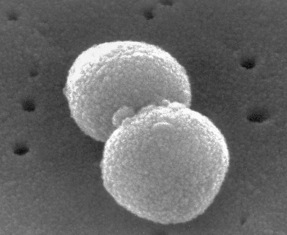
Streptococcus pneumoniae
last authored: Feb 2010, David LaPierre
last reviewed:
Introduction

S. pneumoniae, scanning electron microscope
courtesy of the CDC, PHIL #263
Streptococcus pneumoniae, or pneumococcus, is a leading cause of bacterial infection worldwide, so much so that Sir William Osler referred to it as 'the captain of the men of death'.
Pneumococcus is a common colonizer, but is the most common cause of bacterial pneumonia, other respiratory infections, and meningitis, leading to causes more than a million deaths annually worldwide (ref). This increasingly worrisome due to emerging antibiotic resistance.
Much of its virulence derives from its polysaccharide capsule. Infections with pneumococcus can be prevented with vaccination against capsule components.
The Case of Min Li
Min is an 86 year-old woman who develops a runny nose, dry cough, and low fever. She improves over a few days, but then experiences a sudden worsening, with high fever, shortness of breath, and chest pain.
What is happening to Min?
Epidemiology
Pneumococcus colonizes the nasopharynx in 5-10% of adults and 20-40% of children.
Disease is more common in:
- winter and early spring
- infants or elderly
- smokers
- people with low socio-economic status
- pts with defective antibody formation or neutropenia, or with chronic respiratory disease
- patients with diabetes, alcoholism, liver disease, sickle cell anemia, HIV
- asplenic patients
- day cares, military, and prisons
Classification and Characteristics
Pneumococcus is a small, gram positive diplococci. It is aerobic and able to tolerate environmental levels of oxygen. Most are encapsulated.
Virulence Factors
capsule
lacks catalase
|
pneumolysin (hemolysin)
secretory IgA protease |
Transmission and Infection
Pneumococcus has a reservoir in the humans who are colonized by it. Transmission is by respiratory droplets or by skin-to-skin, and is very efficient.
Infection of the respiratory tract appears to occur shortly after colonization, with disease severity depending on specific strain. Disease becomes established in sterile sites, such as the lungs, if normal defence mechanisms (cough reflex, ciliary elevator, etc) are beaten.
In pneumonia, the alveoli first fill with serous fluid as a result of the inflammatory response. This fluid allows spread of bacteria into adjacent alveoli, reducing gas exchange.
During early consolidation, neutrophils and RBCs enter the alveoli, prompted by cytokine release. Opsonization occurs, initially via complement but eventually mediated by antibodies. C-reactive protein (CRP) binds to bacteria and can also lead to complement activation.
Late consolidation and resolution follow success by the immune system, with neutrophils being replaced by macrophages. Pneumococal pneumonia is distinct in that the lung architecture is usually restored.
Clinical Manifesations
Pneumonia often follows viral illness, with pleural effusion or empyema occurring at times. Other forms of respiratory infections include:
It can also cause
Diagnosis
In the case of pneumonia, sputum culture should follow gram stain. An initial stain of neutrophils and gram-positive diplococci suggests pneuomocci. Blood culture should also be carried out. Pneumococci are fastidious, and a negative culture does not rule out infection.
The bacteria are alpha hemolytic, bile soluble, and a sensitive to a compound called Optochin S.
Treatment
Antibiotic used depends on site of infection, co-morbidities, degree of illness, and ambulatory vs inpatient. Choices include penacillins, cephalosporins, macrolides, and fluoroquinolones.
Penicillin resistance has increased in recent years, with the mechanism of action being mutation of penicillin-binding proteins. Resistance to macroides and TMP/SMX is also increasing.
Fluoroquinolines, especially levofloxacin, should be reserved for serious disease. It can be used empirically, though susceptibility testing should be done.
A pneumococcal vaccine is now available for seniors and for children. Pneumovax covers 23 different polysaccharides that account for 90% of invasive strains As Strep. pneumo is encapsulated, peptide vaccines don't work well, and protection wanes with time and age.
Indications for vaccine include:
- advanced age
- splenectomy
- HIV/AIDS
- lymphoma
- myeloma
- alcoholism
- diabetes
Prevnar is a congugate vaccine for use in infants under 2 years of age
